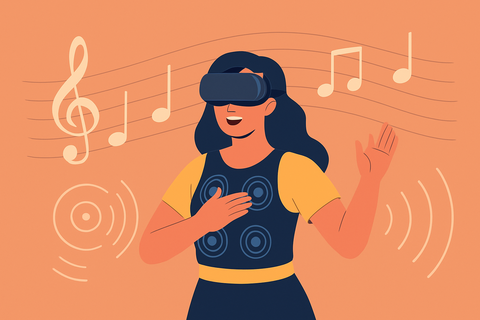10.11.2025
Musik fühlen: Haptik und die Zukunft des verkörperten Hörens
Was macht ein kulturelles Erlebnis unvergesslich? Eine Studie unter der Leitung unserer Junior-Professorin Merle Fairhurst an der Tate Britain zeigte, dass die Erinnerung deutlich verbessert wird, wenn interaktive, multisensorische Reize auf eine stimmige Weise präsentiert werden (Fairhurst et al., 2017). Dies legt nahe, dass die Wirkung des Erlebnisses umso intensiver ist, je stärker unsere Sinne gemeinsam einbezogen werden.
Musik ist in diesem Sinne ein besonders eindrucksvolles Beispiel. Sie animiert uns ganz natürlich zum Mitwippen, Mitsingen oder sogar zum Tanzen und Mitsingen. Da Musik bereits auf diese Weise verkörpert ist, bietet sie eine einzigartige Möglichkeit, die multisensorische Wahrnehmung zu maximieren. Und dank der Fortschritte bei immersiven Technologien können wir nun erforschen, wie sich das Hörerlebnis auf weitere Sinnesbereiche ausdehnen lässt.
So hat die Forschung beispielsweise gezeigt, dass musikalische Merkmale wie Rhythmus und Dynamik in visuelle Signale übersetzt werden können, was Neulingen hilft, musikalische Strukturen zu verstehen und die Zugänglichkeit für Menschen mit Hörbeeinträchtigungen verbessert (Nanayakkara et al., 2013). Stellen Sie sich vor, Sie erleben ein Konzert in virtueller Realität, wobei der Rhythmus durch pulsierende Formen dargestellt wird, die um Sie und das Publikum herum schweben.
Hier kommt die Haptik ins Spiel. Haptische Technologien, die Informationen über Berührung vermitteln, können Musik greifbar machen. Stellen Sie sich vor, Sie tragen während des oben erwähnten virtuellen Konzerts eine haptische Weste. Stellen Sie sich pulsierende Vibrationen auf Ihrer Brust vor, synchron zum Musikrhythmus; oder die Lautstärke der Musik wird durch Veränderungen der Intensität dieser Vibrationen vermittelt. Obwohl es sich noch um ein Entwicklungsgebiet handelt, experimentieren Forscher bereits mit vibrotaktilen Aktuatoren, die am Körper angebracht werden, um Teilnehmern mit Hörbeeinträchtigungen die Auseinandersetzung mit Musik zu ermöglichen (Paisa et al., 2023). Andere Forscher haben multisensorische Erweiterungen der Musik für Kinder mit Behinderungen untersucht und damit neue Wege des Lernens und der Interaktion eröffnet (Frieden et al., 2022).
Das Potenzial multisensorischer Musikerlebnisse geht weit über die bloße Zugänglichkeit hinaus. Indem Haptik Musik zu einem intensiveren, körperlich erfahrbaren Erlebnis macht, kann sie die Auseinandersetzung mit dem Medium vertiefen, das Lernen verbessern und neue Formen künstlerischen Ausdrucks ermöglichen. Kurz gesagt: Wir bewegen uns möglicherweise auf eine Zukunft zu, in der Musik nicht nur gehört, sondern auch gesehen, gefühlt und gelebt wird.
Wir möchten Ihnen zum Abschluss zwei Fragen mitgeben:
Wie kann haptische Technologie unsere emotionale und körperliche Verbindung zur Musik über traditionelle Hörerlebnisse hinaus erweitern?
Inwiefern können multisensorische Ansätze wie Berührung und Bewegung die Zugänglichkeit und Inklusion bei Musikdarbietungen verbessern?

